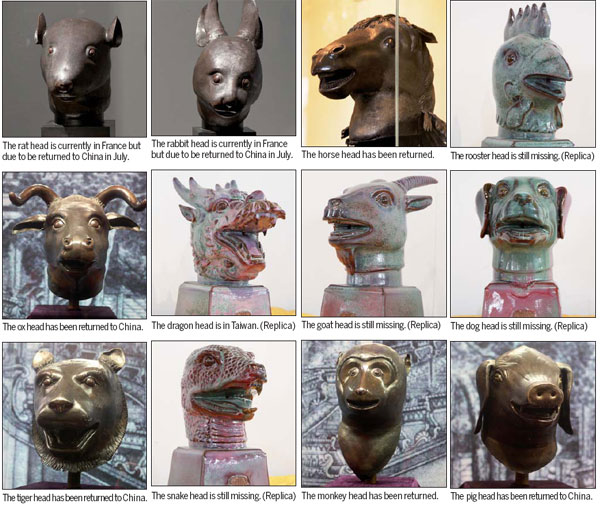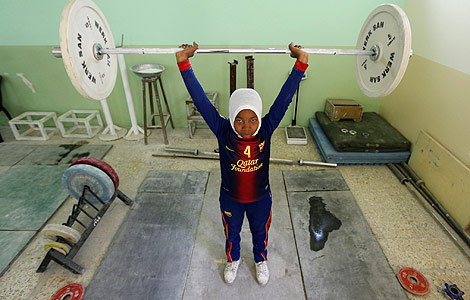Cast in bronze and memory
Updated: 2013-05-03 08:30
By Ji Xiang (China Daily)
|
|||||||||||

Twelve zodiac sculptures looted from Beijing's Old Summer Palace have become a symbol for cultural relics that the country wants returned, both because of their beauty and historical significance
Looted relics have been a hot topic in China in recent years and were back in the news last month when it was announced that two bronze sculptures taken from Beijing during a joint attack by British and French forces in 1860 will be returned to the country.
The rat and rabbit head figures are part of an original set of 12 sculptures representing the Chinese zodiac, from Emperor Qianlong's zodiac fountain in the Old Summer Palace in Beijing. Like many other items taken by foreign powers during times of unrest, several of the sculptures remain overseas or missing.
The sculptures have been a much-discussed issue in China and were even the subject of the popular action movie CZ12, also known as Chinese Zodiac, co-produced, written, directed and starring Jackie Chan, which was came out last year. The plot turns on Jackie Chan's character returning the remaining zodiac sculptures that are overseas to China. It was a runaway success in China, partly because of Chan's popularity, but also because of the country's fascination with these particular relics.
The sculptures are just a handful of the estimated 10 million Chinese cultural relics taken from the country between 1840 and 1949, but they represent a strong symbol for China, because of their beauty and the history attached to them.
Artistically, the sculptures are a marvel worthy of the emperor's palace in which they originally stood. Italian missionary Giuseppe Castiglione (1688-1766) designed the 12 bronze heads based on the Chinese zodiac. Serving as part of an ornamental fountain, each sat atop a sculpture of a human body clad in traditional Chinese robes.
Castiglione originally intended for each to sit on a sculpture of a naked woman, as is common in the West, but Emperor Qianlong thought this was contrary to Chinese ethics and ordered a change of design. Thus was produced an artistic fusion of East and West.
Each of the heads is exquisitely made down to details such as wrinkles and individual hairs, and because they were cast in bronze remain in fine condition.
The fountain that they were a part of served as a clock that was in front of Haiyan Hall in the Old Summer Palace. The 12 sculptures stood on each side of the fountain pond, with the cow, rabbit, snake, goat, rooster and pig on the northern edge and the rat, tiger, dragon, horse, monkey and dog on the southern edge.
A different animal fountainhead would spray water every two hours, counting the passing of the day, and all the fountains would spray together at noon.
However, their importance was not just as an attractive timepiece. The zodiac was an important part of Chinese culture that affected many aspects of life. Each animal represented a year, and before widespread literacy they were used as a means of expressing the year of someone's birth. They were also said to determine fate and suitable marriage partners.
The looting of the sculptures from the Old Summer Palace happened during the Second Opium War. Two British envoys and a journalist from The Times newspaper, with an escort of Indian and British soldiers sent to negotiate with Beijing, were imprisoned and tortured and a number of them died. In retaliation, British and French troops acting on the orders of Lord Elgin destroyed the palace, taking the fountainheads and other artifacts with them.
To date, five of the 12 bronze animal fountainheads - the cow, tiger, monkey, pig and horse - have been returned to China through auction purchases or as a result of donations. The dragon head remains in Taiwan and a further four - the snake, goat, rooster and dog - are still to be found.
While important, the sculptures represent a small part of the estimated 1.5 million objects taken from the Old Summer Palace, that are now housed in more than 2,000 museums in 47 countries.
Song Xinchao, deputy director of State Administration of Cultural Heritage, met the Pinault family from France, who are returning the two bronze sculptures to China, on the morning of April 26 and later said he hoped to see them on Chinese soil again by July and housed at the National Museum.
jixiang@chinadaily.com
(China Daily 05/03/2013 page26)
Today's Top News
China's automaker to open 1st US plant
Two preschool girls die from poisoning
Academic elected into US science academy
Beijing acts on complaints against airport cabbies
Military denies expensive vehicle had new plate
Police in major crackdown on tainted meat
Joint fund on hunt for investment opportunity
A-share firms' overall profits flat-lining
Hot Topics
Lunar probe , China growth forecasts, Emission rules get tougher, China seen through 'colored lens', International board,
Editor's Picks

|

|

|

|

|

|





